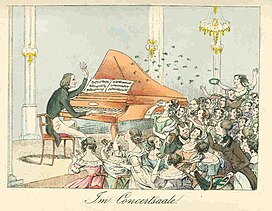
Frédéric François Chopin was a Polish composer and virtuoso pianist of the Romantic period, who wrote primarily for solo piano. He has maintained worldwide renown as a leading musician of his era, one whose "poetic genius was based on a professional technique that was without equal in his generation".

Clara Josephine Schumann was a German pianist, composer, and piano teacher. Regarded as one of the most distinguished pianists of the Romantic era, she exerted her influence over the course of a 61-year concert career, changing the format and repertoire of the piano recital by lessening the importance of purely virtuosic works. She also composed solo piano pieces, a piano concerto, chamber music, choral pieces, and songs.

Franz Liszt was a Hungarian composer, virtuoso pianist, conductor and teacher of the Romantic period. With a diverse body of work spanning more than six decades, he is considered to be one of the most prolific and influential composers of his era, and his piano works continue to be widely performed and recorded.

Christian Johann Heinrich Heine was a German poet, writer and literary critic. He is best known outside Germany for his early lyric poetry, which was set to music in the form of Lieder by composers such as Robert Schumann and Franz Schubert. Heine's later verse and prose are distinguished by their satirical wit and irony. He is considered a member of the Young Germany movement. His radical political views led to many of his works being banned by German authorities—which, however, only added to his fame. He spent the last 25 years of his life as an expatriate in Paris.
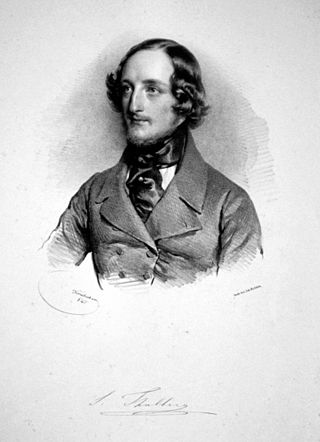
Sigismond Thalberg was an Austrian composer and one of the most distinguished virtuoso pianists of the 19th century.
The "War of the Romantics" is a term used by some music historians to describe the schism among prominent musicians in the second half of the 19th century. Musical structure, the limits of chromatic harmony, and program music versus absolute music were the principal areas of contention. The opposing parties crystallized during the 1850s. The most prominent members of the conservative circle were Johannes Brahms, Joseph Joachim, Clara Schumann, and the Leipzig Conservatoire, which had been founded by Felix Mendelssohn. Their opponents, the radical progressives mainly from Weimar, were represented by Franz Liszt and the members of the so-called New German School, and by Richard Wagner. The controversy was German and Central European in origin; musicians from France, Italy, and Russia were only marginally involved.

Heinrich Friedrich Ludwig Rellstab was a German poet and music critic. He was born and died in Berlin. He was the son of the music publisher and composer Johann Carl Friedrich Rellstab. An able pianist, he published articles in various periodicals, including the influential liberal Vossische Zeitung, and launched the music journal Iris im Gebiete der Tonkunst, which was published in Berlin from 1830 to 1841. His outspoken criticism of the influence in Berlin of Gaspare Spontini landed him in jail in 1837.

The Piano Sonata in B minor, S.178, is a piano sonata by Franz Liszt. It was completed in 1853 and published in 1854 with a dedication to Robert Schumann.
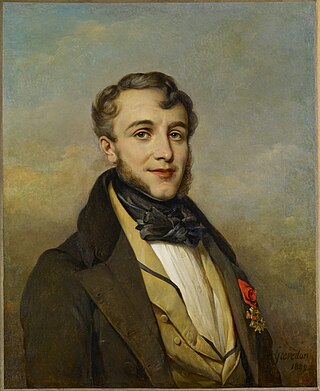
Friedrich Wilhelm Michael Kalkbrenner, also known as Frédéric Kalkbrenner, was a pianist, composer, piano teacher and piano manufacturer. German by birth, Kalkbrenner studied at the Conservatoire de Paris, starting at a young age and eventually settled in Paris, where he lived until his death in 1849. Kalkbrenner composed more than 200 piano works, as well as many piano concertos and operas.

Adamus List was the father of composer and pianist Franz Liszt.

Lisztomania is a 1975 British surreal biographical musical comedy film written and directed by Ken Russell about the 19th-century composer Franz Liszt. The screenplay is derived, in part, from the book Nélida by Marie d'Agoult (1848), about her affair with Liszt.

Song Without End, subtitled The Story of Franz Liszt, is a 1960 biographical film romance about Franz Liszt made by Columbia Pictures. It was directed by Charles Vidor, who died during the shooting of the film and was replaced by George Cukor. The film stars Dirk Bogarde, Capucine, and Geneviève Page.
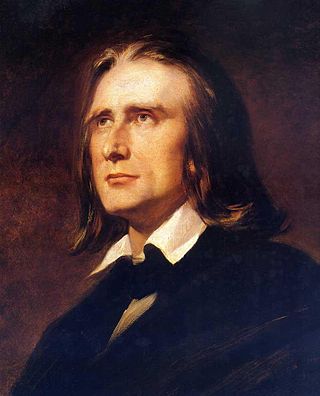
Les préludes, S.97, is the third of Franz Liszt's thirteen symphonic poems. The music was composed between 1845 and 1854, and began as an overture to Liszt's choral cycle Les quatre élémens, then revised as a stand-alone concert overture, with a new title referring to a poem by Alphonse de Lamartine. Its premiere was on 23 February 1854, conducted by Liszt himself. The score was published in 1856 by Breitkopf & Härtel. Les préludes is the earliest example of an orchestral work entitled "Symphonic Poem".
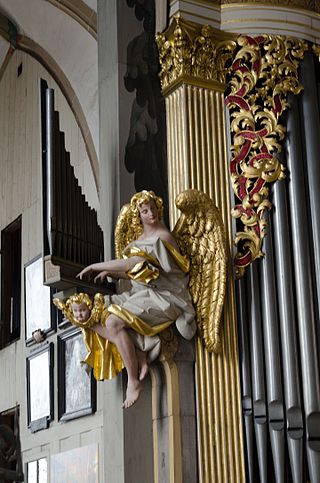
Prelude and Fugue in A minor, BWV 543 is a piece of organ music written by Johann Sebastian Bach sometime around his years as court organist to the Duke of Saxe-Weimar (1708–1713).

The symphonic poems of the Hungarian composer Franz Liszt are a series of 13 orchestral works, numbered S.95–107. The first 12 were composed between 1848 and 1858 ; the last, Von der Wiege bis zum Grabe, followed in 1882. These works helped establish the genre of orchestral program music—compositions written to illustrate an extra-musical plan derived from a play, poem, painting or work of nature. They inspired the symphonic poems of Bedřich Smetana, Antonín Dvořák, Richard Strauss and others.

Walter Bache was an English pianist and conductor noted for his championing the music of Franz Liszt and other music of the New German School in England. He studied privately with Liszt in Italy from 1863 to 1865, one of the few students allowed to do so, and continued to attend Liszt's master classes in Weimar, Germany regularly until 1885, even after embarking on a solo career. This period of study was unparalleled by any other student of Liszt and led to a particularly close bond between Bache and Liszt. After initial hesitation on the part of English music critics because he was a Liszt pupil, Bache was publicly embraced for his keyboard prowess, even as parts of his repertoire were questioned.
Although Franz Liszt provided opus numbers for some of his earlier works, they are rarely used today. Instead, his works are usually identified using one of two different cataloging schemes:
"Music of the Future" is the title of an essay by Richard Wagner, first published in French translation in 1860 as "La musique de l'avenir" and published in the original German in 1861. It was intended to introduce the librettos of Wagner's operas to a French audience at the time when he was hoping to launch in Paris a production of Tannhäuser, and sets out a number of his desiderata for true opera, including the need for 'endless melody'. Wagner deliberately put the title in quotation marks to distance himself from the term; Zukunftsmusik had already been adopted, both by Wagner's enemies, in the 1850s, often as a deliberate misunderstanding of the ideas set out in Wagner's 1849 essay, The Artwork of the Future, and by his supporters, notably Franz Liszt. Wagner's essay seeks to explain why the term is inadequate, or inappropriate, for his approach.

"Lisztomania" is a song by the French band Phoenix from their fourth album Wolfgang Amadeus Phoenix. It is their second single from the album, although a music video of the song was released before "1901". The music video shows them walking around Bayreuth, Germany, inside and outside the Franz Liszt Museum, Wahnfried, the Bayreuth Festspielhaus, sitting inside the Festspiel Theatre, performing live and going outside to find a blimp like the one shown on the album cover. The song helped the album to be their most successful following their previous hit, "1901".

Wendelin Weißheimer was a German composer, conductor, essayist, teacher, and writer on music. He studied with Franz Liszt and was in close contact with Richard Wagner, Hans von Bülow, Peter Cornelius, Louise Otto-Peters, Ferdinand Lassalle, August Bebel and many other notable musicians of his time.
